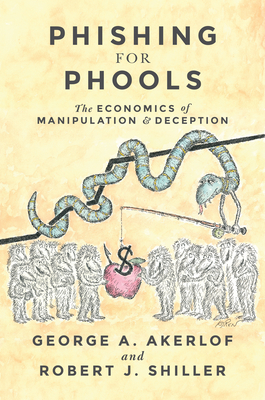Phishing for Phools: The Economics of Manipulation and Deception
George A. Akerlof

This book has a reasonable concept behind it but is poorly executed in my opinion. The authors don’t really give a clear idea of why they are writing the book until the very end. To give my own summary with the best possible spin, the authors (two very prominent economists) are interested in linking findings of behavioral economics with partial equilibrium (and perhaps general equilibrium) microeconomics. In general, the discipline of behavioral economics has focused heavily on special cases and experimental evidence. Certainly authors like Kahneman and Tversky have developed taxonomies of known “heuristics and biases,” but these are generally not mined for broader implications for market clearing and welfare economics. This is what Akerlof and Shiller would like to see. The book is very non-technical and only gestures in this direction, but generally, the authors create a microeconomic picture where individuals' weaknesses and biases play more or less as prominent of a role in technological development and investment in a given market as do individuals' “true” preferences (more on those scare quotes below). Presumably, this could even lead to implications regarding aggregate investment and productivity growth. In this picture, weaknesses and biases are not curious exceptions, but something closer to the rule. It is hard to look at the evolution of the food industry and doubt that there is some truth to this view.
That said, the book has many weaknesses. First, because of the authors' attempts to write for a general-interest audience, there are only the vaguest gestures in the direction of this unifying perspective. As a result, the book primarily comes across as a piling-up of examples of specific cases where companies take advantage of individual weaknesses and biases–which is exactly what I think the authors see as a shortcoming of the existing behavioral economics literature!
Second, because the constant use of the terms “phishing” and “phools” is insufferable. It’s bad enough that the authors try to commandeer “phishing,” which is already a well-defined term that does not mean what they use it to mean. It’s really a distraction from any kind of actual substance that might be delivered, and I think it also to some degree denies the agency of the consumer. The authors certainly don’t ever discuss what one can do to be less of a “phool.” To the extent that “phishing behavior” is as endemic as the authors portray it, I think it implies a fairly radical level of skepticism, reliance on the precautionary principle, and active avoidance of advertising and other capitalist situations–which I am not sure the authors would be ready to endorse explicitly. Something that might be endorsed by, say, E.F. Schumacher.
Third, it’s not clear who the right audience for this book is. In the conclusion, the authors say that they hope to influence the direction of research in economics, but I feel like a popular consumption book like this is about the worst way to do that. To the extent that the target audience is everyday people (as the style implies), it is hardly news to us (and to economists when they are not acting in their professional capacity) that corporations look for opportunities to take advantage of people for profit.
Fourth, the authors mix together under the broad heading of “phishing” what they call “information phishing” (situations of asymmetric information) and “psychological phishing” (situations of weaknesses and biases). It’s not clear to me why these should be analyzed together, other than that they both suck. Asymmetric information has been extensively studied in economics, most prominently by Akerlof himself, with the general conclusion being that asymmetric information results in market failure (no market can be sustained even if welfare-enhancing trades are in principle available). The authors don’t give much explanation for why they think markets are sustained in the examples they give. Asymmetric information problems are also often amenable to top-down solutions, such as disclosure laws, requiring warranties, requiring insurance, etc. Weakness/bias situations, on the other hand, aren’t likely to result in market failure, and the proposed solution typically involves some type of “nudge,” which may or may not be very effective.
Fifth and finally, as this review has gone on long enough, the authors too readily distinguish between our “real” preferences and what they call our “monkey on the shoulder,” or irrational preferences. They laud capitalism for helping us fulfill our “real” preferences but castigate it for helping us fulfill the monkey ones. Surely there is a great deal of truth to this, but the thing that makes this such a dicey issue is that it is very difficult to distinguish between these two classes of preference, and I’m not sure how much of a distinction there really is. For example, the authors spend a great deal of ink talking about how advertisers “phish” people by selling them a story about something, and getting people to identify with that story. They basically portray this as bad, and in some limiting cases I can certainly see that. But take the example of sports fandom, and economically speaking, the purchase of game tickets, team paraphernalia, etc. What is being a fan of a sports team other than buying into a story and identifying with it, along with a bunch of other people? If the authors are skeptical about whether this is “truly” valuable to people, they need to watch Doris Kearns Goodwin talk about the Dodgers and Red Sox in the Ken Burns baseball documentaries. At best, and the authors do not at all draw this conclusion, I think this line of analysis can lead us to understand how important it is to be reflective about our own preferences and assess whether our budgets instantiate our values.
My favorite part of this book was learning that Bob Shiller ate cat food, in order to prove some point that didn’t really make sense to me.